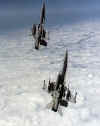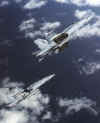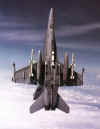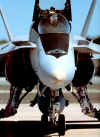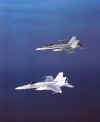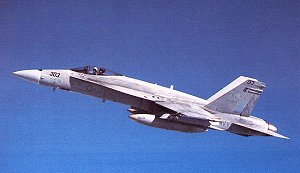 The McDonnell-Douglas F/A-18 Hornet was the result of a competition for a
lightweight fighter for the USAF and US Navy. The submission of the F-17 by Northrop was
in competition with the General Dynamics F-16. In the end the F-16 was selected for the
USAF, while the F-17 was developed and built by McDonnell- Douglas into the F/A-I 8 Hornet
for the US Navy, which had stated a requirement for 1,350 aircraft.
The McDonnell-Douglas F/A-18 Hornet was the result of a competition for a
lightweight fighter for the USAF and US Navy. The submission of the F-17 by Northrop was
in competition with the General Dynamics F-16. In the end the F-16 was selected for the
USAF, while the F-17 was developed and built by McDonnell- Douglas into the F/A-I 8 Hornet
for the US Navy, which had stated a requirement for 1,350 aircraft.
The first F/A-18 took to the air on 18 November 1978. The Hornet entered service with the US Navy in 1982. As a fighter it could carry Sidewinder and Sparrow air-to-air missiles. The wing tips fold upwards to reduce the footprint of the aircraft. Even on US Navy carriers space is at a premium, and the Hornet's ability to fold the wing tips helps to ease the problem. The F/A-18 is fitted with the APG-65 multi-mode radar which enables it to track up to ten targets simultaneously. The F/A-18C and the two seat F/A-18D appeared in 1987. These were fitted with a much improved computer system, improved EW and ejector seat, the IR Maverick ground attack missile and the capability of operating the new AMRAAM missile. The Hornet has been given a night-attack capability by the inclusion of a Forward Looking Infra Red (FLIR) system and a Thermal Imaging Navigation Set (TINS). This resulted in the designation F/A-18 D, while a further variant the RF-18D is a two seat reconnaissance aircraft, fitted with electro-optical and IR sensors plus a pod mounted sideways looking radar.
SPECIFICATION
Span:37 ft 6 in / 11.43 m
Length: 56 ft / 17.07 m
Height: 15 ft 4 in / 4.66 m
Weight: 36,710 lb empty / 49,224 lb max. take-off
Armament: One 20mm M61A1 Vulcan six-barrel cannon with 570 rounds, plus up to
17,000 lb including bombs, rockets, missiles, and drop tanks on nine external points
Engines: Two General Electric F404-400 afterburing turbofans, 16,000 lb thrust each
PERFORMANCE
Speed: 1,189 mph / 1.913 km/h
Range: 2,303 miles / 3,706 km
Ceiling: 50,000 ft / 15240 m

